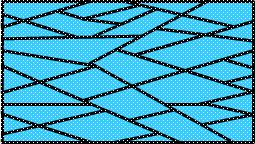Re-use of this resource is governed by a Creative Commons
Attribution-
NonCommercial-ShareAlike 4.0 International
https://creativecommons.org/licenses/by-nc-sa/4.0/
NonCommercial-ShareAlike 4.0 International
https://creativecommons.org/licenses/by-nc-sa/4.0/
Simple Examination of a Composite
Composites, consisting of some elongated structure contained
within a 3D matrix, cannot be examined simply by looking at the surface.
For example, a short fibre composite may look like this:
For example, a short fibre composite may look like this:
If you take a cross-section in the x-y plane, the fibres
can be observed.
Matrix
Short fibres
Quantitative analysis of the composite can then be done,
by measuring the area fraction of the fibres, (assuming they are long
fibre composites). This can be recorded by making use of a line fraction,
which, if averaged over a large enough area, will match the area fraction.
A cross-section in the y-z plane means that you can identify
what strengthening methods are used.
There are three likely possibilities
Long fibre composite-in which the fibres run through the
entire matrix.
There are three likely possibilities
A short fibre composite, with only small fibres in the
matrix. This does not provide the same stiffness as long fibre composites,
but can be more isotropic.
There are three likely possibilities

An elongated grain structure can also provide an effect
similar to fibres. More on fibre pullout can be seen in the Fibre composites
TLP.